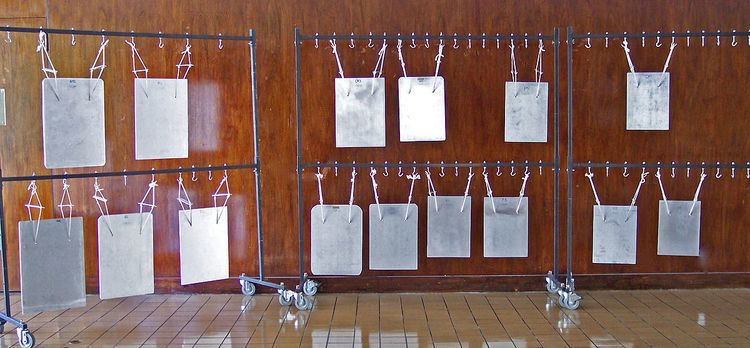Developed Asia | ||
 | ||
Hornbostel–Sachs classification 111.222(Sets of percussion plaques) | ||
A bell plate is a percussion instrument consisting of a flat and fairly thick sheet of metal, producing a sound similar to a bell. They are most often used in orchestral and theater music.
Contents
History
Bell plates were first developed and implemented as percussion instruments in ancient Asia, but did not enter into Western music until the late 19th century. This instrument then became popular, particularly in theater music, in the early 20th century.
Construction
Bell plates are constructed of sheets of aluminum or bronze, ranging in size from 100 by 74 centimetres (39 by 29 in) and 6 kilograms (13 lb) to 28 by 25 centimetres (11.0 by 9.8 in) and 1 kilogram (2.2 lb). The range of the instrument typically covers 4 octaves in the form of a C-major scale, totalling 29 total plates. However, different sets of may contain different combinations of plates according to the needs of the owner. The plates are typically suspended from a semicircular frame and are occasionally fitted with resonators to enhance volume and the sounding of low partials. A variation of the bell plate is the Burma bell, a distinctively shaped bell plate that is often mounted using a single hole, allowing it to spin when struck, producing doppler effects.
Playing techniques
Bell plates can be played while suspended from a stand or while held in one hand of the performer depending of the number of different plates needed for a specific performance. If only one plate is needed, then the performer will simply hold that specific plate with one hand and strike it with the other. This plate can be kept on a table covered with a towel or carpet square while not being played. If the performance requires several plates to be played in succession, then the plates should be suspended from a stand. The player then strikes the plates with a wooden, hard plastic, or metal mallet which can be covered in varying thicknesses of felt to create a variety of sounds. A softer mallet, which has a thicker felt covering, can achieve a greater sounding of the fundamental pitch of the plate, while a harder mallet with a thinner covering of felt will produce stronger overtones and possibly overshadow the fundamental pitch of the plate. The sound can also be manipulated by striking different areas of the plate. Greater volume can be achieved by striking the center of the lower or upper third of the instrument, and a clearer pitch can be produced by striking the plate at the center or near the bottom edge. The Bell Plates may be dampened with the player's hand or with the mallet to quicken or immediately cut off the decay of the sound after striking.
Works
The following works feature bell plates:
External links
Strauss, Also Sprach Zarathustra. Bell plates notated on pg. 16
Bell plate played on youtube
Pierre Boulez - Pli selon pli, view of Bell Plates in orchestral setting at :58, hear bell plates at 1:37
